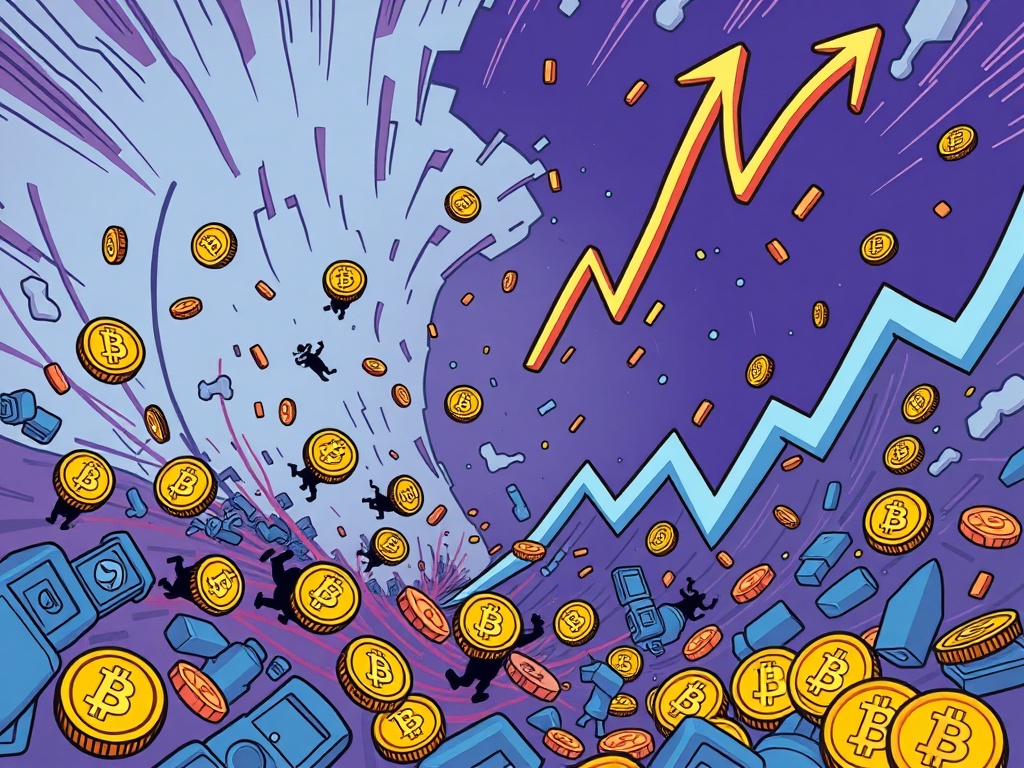BitcoinWorld

Crypto Cycle: Revolutionizing Market Dynamics Beyond the Four-Year Pattern
For years, the cryptocurrency world has lived by an unspoken rule: the four-year crypto cycle. It’s been as predictable as the seasons, often tied to Bitcoin’s halving events, bringing with it periods of exhilarating highs and gut-wrenching lows. But what if this deeply ingrained pattern is starting to unravel? What if the very foundations that have dictated market behavior are shifting, paving the way for something entirely different?
That’s precisely the provocative argument put forth by Matt Hougan, Chief Investment Officer at Bitwise. In a recent observation shared on X, Hougan suggests that the traditional four-year crypto cycle, as we know it, is losing its grip. This isn’t just a minor tweak; it’s a fundamental re-evaluation of how the crypto market operates, driven by powerful new forces that could reshape its future trajectory.
Understanding the Traditional Four-Year Crypto Cycle: Was it a Myth or a Blueprint?
Before we delve into why the old rules might be faltering, let’s briefly revisit what the traditional four-year crypto cycle entailed. Historically, this cycle was heavily influenced by several key factors, creating a rhythm that many investors learned to anticipate:
- Bitcoin Halving Events: Occurring roughly every four years, these events cut the reward for mining new Bitcoin by half, historically leading to supply shocks and price surges in the subsequent months. Many believed this was the primary engine of the cycle.
- Macroeconomic Cycles: The broader global financial environment, particularly interest rate cycles and liquidity conditions, often played a significant role. Periods of negative or low interest rates typically encouraged risk-on assets like crypto.
- Boom and Bust Narratives: Each cycle often culminated in a speculative frenzy, followed by a dramatic market correction or “crypto winter,” purging excesses and setting the stage for the next upswing.
- Retail-Driven Volatility: Early cycles were largely driven by retail investor sentiment, leading to exaggerated price movements and periods of intense FOMO (Fear Of Missing Out) and FUD (Fear, Uncertainty, and Doubt).
This pattern offered a somewhat comforting, albeit volatile, roadmap for investors. But as the crypto market matures, its dynamics are evolving.
Why the Old Rules Are Faltering: Insights from Bitwise CIO Matt Hougan
Matt Hougan’s thesis isn’t just about a feeling; it’s rooted in observable shifts in the market’s underlying drivers. He identifies several reasons why the traditional four-year crypto cycle is weakening:
Diminishing Importance of Block Halving?
While Bitcoin halvings will continue to reduce new supply, their impact on overall market dynamics might be less pronounced than in previous cycles. As the market capitalization of Bitcoin and the broader crypto ecosystem grows, the proportional impact of halving the new supply becomes smaller. The market is deeper, more liquid, and influenced by a wider array of factors beyond just supply-side shocks.
The End of Negative Rate Cycles
For much of the last decade, global central banks maintained ultra-low or even negative interest rates, pushing investors into riskier assets in search of yield. This environment was highly conducive to crypto’s growth. However, with inflation concerns and a global shift towards higher interest rates, this tailwind has largely dissipated. The absence of a negative rate cycle removes a significant historical driver of speculative capital into crypto.
Reduced Blow-Up Risk and Market Maturity
Past cycles were often punctuated by dramatic “blow-ups”—major project failures, exchange collapses, or liquidity crises (think Mt. Gox, Luna/Terra, FTX). These events acted as resets, clearing out bad actors and unsustainable projects. While risks will always exist, the crypto ecosystem has matured significantly. Infrastructure is more robust, regulatory scrutiny is increasing, and investors are arguably more sophisticated. This reduction in systemic blow-up risk means fewer dramatic market purges, leading to a potentially smoother, albeit less explosive, growth trajectory.
A New Cyclical Threat: Rising Treasury Companies
Hougan also points to a new, emerging cyclical threat: the rise of Treasury companies. As interest rates rise, traditional, low-risk investments like U.S. Treasury bonds become more attractive. This could divert institutional and even retail capital away from riskier assets like crypto, posing a new challenge to market liquidity and capital flows. This dynamic adds another layer of complexity to the market that wasn’t as prominent in previous cycles.
New Pillars of Growth: What’s Driving the “Sustained Steady Boom” in the Crypto Cycle?
Despite the weakening of old drivers, Hougan isn’t bearish. Quite the opposite. He identifies powerful, longer-term forces that are gaining momentum, potentially creating a “sustained steady boom” rather than the classic super-cycle characterized by extreme peaks and troughs. These forces represent a fundamental shift in how the crypto cycle might unfold:
- Spot Bitcoin ETFs: The Gateway to Mainstream Capital: The approval and launch of spot Bitcoin Exchange-Traded Funds (ETFs) in the U.S. represent a monumental shift. These ETFs provide a regulated, accessible, and familiar investment vehicle for traditional investors, institutions, and financial advisors who were previously hesitant to directly hold cryptocurrencies. This influx of “sticky” institutional capital provides a new, consistent demand source, potentially smoothing out volatility and offering a more stable base for price discovery.
- Broad Institutional Adoption: Beyond ETFs: The influence extends far beyond just ETFs. Major financial institutions, corporations, and even sovereign wealth funds are increasingly exploring and integrating blockchain technology and digital assets into their operations. This includes tokenization of real-world assets, use of blockchain for supply chain management, and direct investment in crypto assets. This widespread adoption signifies a move from speculative interest to fundamental utility and integration into the global financial system.
- Multi-Year Regulatory Reforms: The US GENIUS Act and Beyond: Regulatory clarity has long been a missing piece in crypto’s maturation. The ongoing discussions and potential implementation of multi-year regulatory reforms, such as those envisioned by the U.S. GENIUS Act (which aims to provide a clear framework for digital assets), are crucial. Clear regulations reduce uncertainty, foster innovation within established guidelines, and provide investor protection, making the market more attractive to institutional players and the general public. This regulatory evolution is laying the groundwork for sustainable, compliant growth.
These forces suggest a future where the crypto cycle is less about dramatic, speculative surges and more about steady, incremental growth driven by fundamental adoption and increasing utility. While volatility will always be a part of the crypto landscape, the underlying trend could be significantly more robust and sustained.
Navigating the Future: Volatility and the Path to 2026 for the Crypto Cycle
It’s important to temper expectations with a dose of reality: crypto is still crypto. Volatility will remain a characteristic of the market. However, Hougan’s outlook suggests that these powerful pro-crypto trends—institutional integration, regulatory clarity, and increased accessibility—are strong enough to carry the market into a robust 2026. This implies a more mature, resilient market that can weather short-term fluctuations better than in previous cycles.
For investors, this shift could mean a re-evaluation of strategies. Perhaps less emphasis on timing the peaks and troughs of a predictable four-year crypto cycle, and more focus on long-term conviction, fundamental value, and the steady accumulation of assets as the ecosystem matures and integrates further into the global economy.
Conclusion: A New Era for the Crypto Cycle?
Matt Hougan’s perspective offers a compelling vision for the future of the crypto cycle. It’s a narrative of evolution, where the wild, unpredictable surges of the past give way to a more measured, institutionalized, and fundamentally driven growth trajectory. The diminishing influence of traditional cycle drivers, coupled with the rising power of institutional adoption, regulatory clarity, and accessible investment vehicles, points towards a sustained boom rather than a fleeting super-cycle.
While the journey to 2026 and beyond will undoubtedly present its own set of challenges and opportunities, the underlying message is one of increasing maturity and integration. The crypto market is not just growing; it’s growing up, setting the stage for a new, potentially more stable, and certainly more impactful era.
Frequently Asked Questions (FAQs) About the Evolving Crypto Cycle
Q1: What is the traditional four-year crypto cycle?
A: The traditional four-year crypto cycle refers to a historical pattern of market behavior, often associated with Bitcoin’s halving events occurring roughly every four years. This cycle typically involved a bull run leading to a peak, followed by a significant correction or ‘bear market’, before the next cycle began.
Q2: Why does Matt Hougan believe the crypto cycle is weakening?
A: Bitwise CIO Matt Hougan suggests the traditional crypto cycle is weakening because key drivers like the importance of block halvings, negative interest rate cycles, and extreme ‘blow-up’ risks are diminishing. He argues that the market is maturing, with new, more stable influences taking precedence.
Q3: What are the new forces driving the crypto market according to Hougan?
A: Hougan highlights several new, powerful forces: the widespread adoption of spot Bitcoin ETFs, broad institutional adoption across various sectors, and ongoing multi-year regulatory reforms, such as those influenced by the U.S. GENIUS Act. These factors are expected to create a more sustained and steady growth environment.
Q4: What is the significance of Spot Bitcoin ETFs in this new crypto cycle?
A: Spot Bitcoin ETFs are crucial because they provide a regulated and accessible gateway for traditional investors, institutions, and financial advisors to gain exposure to Bitcoin without directly holding the cryptocurrency. This opens up the market to a much larger pool of capital, potentially leading to more stable and consistent demand.
Q5: Will volatility disappear if the four-year crypto cycle weakens?
A: No, volatility is expected to remain a characteristic of the crypto market. While the extreme peaks and troughs of the traditional four-year cycle might become less pronounced, the market will still be subject to price fluctuations driven by news, sentiment, and macroeconomic factors. However, the underlying trend is anticipated to be one of more sustained growth.
Q6: What does this mean for long-term crypto investors?
A: For long-term investors, the weakening of the traditional four-year crypto cycle suggests a shift from highly speculative, short-term trading opportunities to a focus on sustained growth driven by fundamental adoption. It may encourage a more ‘buy and hold’ strategy, emphasizing the long-term potential of the asset class as it integrates further into global finance.
If you found this article insightful, please consider sharing it with your network! Help us spread the word about the evolving dynamics of the cryptocurrency market.
To learn more about the latest crypto market trends, explore our article on key developments shaping Bitcoin institutional adoption.
This post Crypto Cycle: Revolutionizing Market Dynamics Beyond the Four-Year Pattern first appeared on BitcoinWorld and is written by Editorial Team





